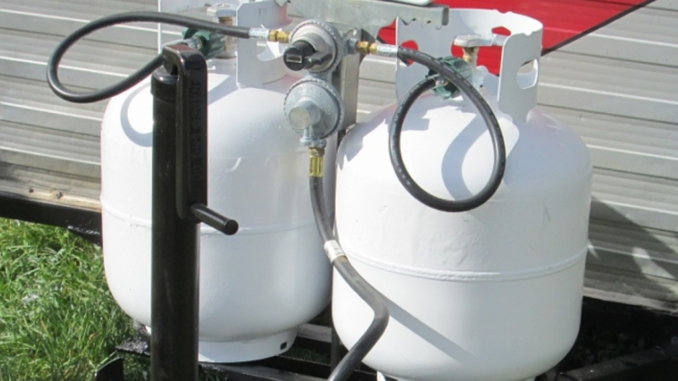
First, let’s look at the two different LP or propane “vessels” used in the RV industry.
Types of propane containers RV use
What does (DOT) mean – Department of Transportation (DOT) cylinders
Department of Transportation (DOT) cylinders are used in travel trailers and 5th wheel units and can be removed and taken to a local filling station. They come in a variety of different sizes such as 20 lb., which is common in the smaller trailers and for grills, and 30- to 40-lb. cylinders used in larger vehicles or fifth wheels.

Example of dual travel trailer cylinders
Advertisement/Affiliate
However they are also available in bigger sizes like 80-lb. models for more extended stay situations, a lot of fulltime RV owners that are parked at a local for serval months. Some RV campground even supply larger tanks in permanent spaces.

Example of fifth wheel fulltime cylinders
According to the DOT website, NFPA 58 requires any DOT cylinders 40 lbs. and under manufactured after September 30, 1998, to have an overfilling protection device (OPD) (valve) that limited filling the cylinder to 80%. The OPD valve is identified with a triangle handle. This cylinder has the fill and supply valve in the same location. It also required any cylinder being refilled to have an OPD valve after April 1, 2002.

Example of OPD valve

Common cylinder and pigtail connection
There is a manufacture date stamped on the handle or colander of the cylinder. These are required to be recertified after 12 years of the manufacture date and every five years after that. The confusion comes from NFPA 58 reclassifying the code in 2017 to change it to 10 years. However, there was much debate and it was reconsidered, and in 2020 it was changed back to 12 years. Even more confusing is because some of the documentation has not been changed yet. This information came directly from the RV Safety & Education Foundation.
American Society Of Mechanical Engineers (ASME) tank
The ASME tank used on motorhomes is a permanently mounted tank that is typically horizontal and in a non-locking compartment. It has a separate fill valve and shut-off valve and has had an OPD valve required since 1983.

Example of motorized horizontal tank
According to the Recreational Vehicle Safety & Education Foundation (RVSEF) and Manchester Tank, the manufacturer of most of the ASME tanks used in the RV industry, they do not need to be recertified as they are built stronger, are permanently mounted, and not subjected to as much element deterioration as the DOT cylinder.
Advertisement/Affiliate
Inspection is required on both by a trained refiller
The most critical issue, in my opinion, is a visual inspection by a trained technician when filling. NPFA 58 does have guidelines for inspection such as dents, rust, and broken parts. The challenge is how well-trained are these “refillers,” since there is no real certification process. Since there are so many LP filling stations popping up at fueling stations and hardware stores, the part-time employee is given a quick filling training that is designed for the 20-lb. grill cylinders and not the larger units that require more advanced knowledge of the system.
I would recommend that you take your tanks to a licensed LP tank store for inspection, if you think there is a concern your typical RV dealership or Repair shop may not have the training or licensing to properly help you.
Learn more about RV Propane Parts & Safety Alarms
Affiliate Link
Gas Leak Detector with Audible & Visual Alarm
More from Dustin
Make sure you check out our website, California RV Specialists, and the YouTube channel for more helpful information, and other social media pages.
